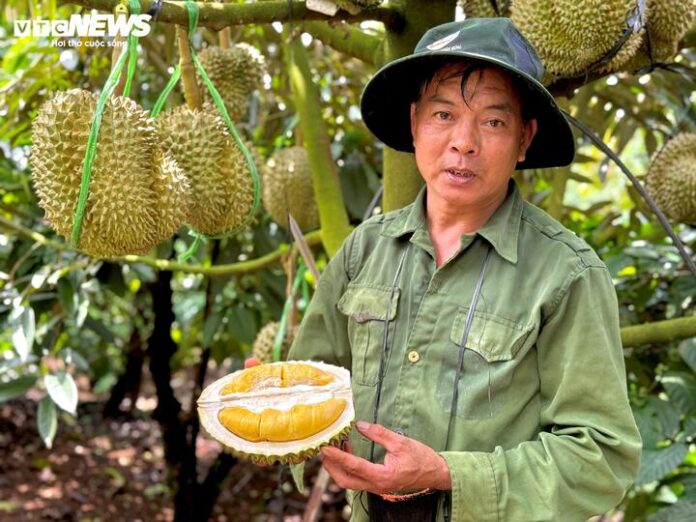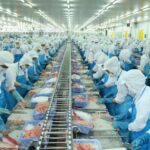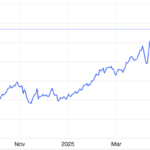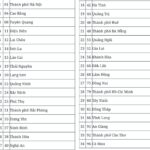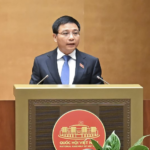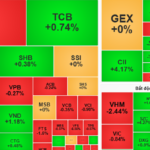In June, heavy rains soaked the Central Highlands of Vietnam. Durian orchards in Binh Phuoc, Dak Nong, and Gia Lai provinces were filled with anxiety. The durian fruits hadn’t had a chance to mature before they were affected by excessive moisture, causing them to become unpalatably mealy. This led to traders breaking their contracts and farmers facing significant losses.
While some farmers received 17,000 VND/kg ($0.71), others were left with broken contracts
Mr. Vu Dang Thanh, a durian farmer in Dak Sin commune, Dak R’lap district, Dak Nong province, led us into his orchard of over 100 trees. With each heavy step he took on the red soil, still wet from the previous night’s rain, his face reflected the weight of the unprecedented losses he was facing this durian season.
“They came to see my orchard, praised the trees, and placed a deposit of 30 million VND ($1,260). They promised to buy the durians at 60,000-65,000 VND/kg ($2.52-$2.73). But after a few prolonged rains, just before the harvest, they returned and said the fruits had become mealy, offering only 30,000 VND/kg ($1.26), ” Mr. Thanh shared, his eyes fixed on the yellowing fruits hanging from the branches.
He admitted that this was the first time in his years of growing durians that he felt so helpless.
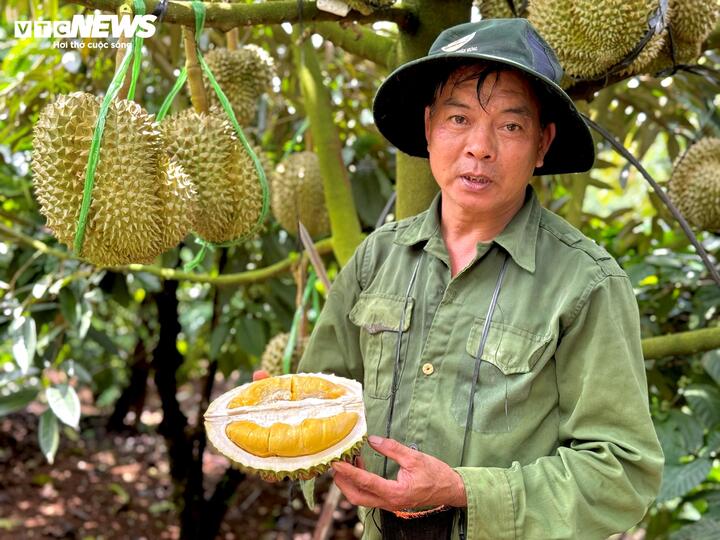
Mr. Vu Dang Thanh from Dak Sin commune, Dak R’lap district, Dak Nong province.
Not far from Mr. Thanh’s orchard, Ms. Nguyen Thi Nguyen was also distressed due to the mealy condition of her durians. Her orchard has only a few dozen trees, but they represent her entire life’s savings after years of hard work.
“I was so happy to see the fruits almost ready for harvest, thinking that I could finally repay my bank loan. But then…,” Ms. Nguyen choked up, standing silently in front of her trees, which had just borne their first fruits.
A trader came to inspect the fruits, nodded in approval, but as the harvest date approached, he made excuses about the mealy condition, postponed the harvest, and then stopped responding to her calls: “He said he was busy and told me to find another buyer. But who would buy mealy durians? I really can’t blame him, but I feel so helpless and don’t know what to do.”
The widespread occurrence of mealy durians caused a freefall in prices. According to our survey in key growing areas, the prices offered by traders for Thai durians, Musang King durians, and Ri6 durians were 60,000 VND/kg ($2.52), 55,000 VND/kg ($2.31), and 50,000 VND/kg ($2.10) respectively.
However, for orchards with even a small portion of mealy fruits, traders immediately lowered the price to 25,000-35,000 VND/kg ($1.05-$1.48). Some farmers had to accept as low as 17,000 VND/kg ($0.71) to cut their losses.
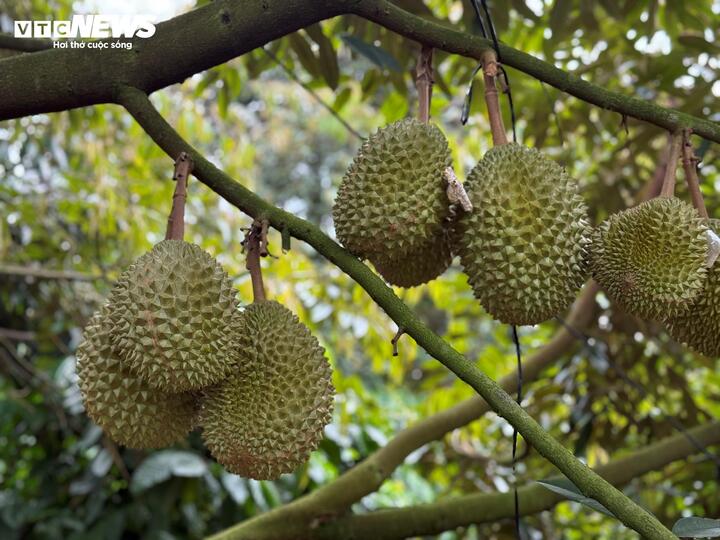
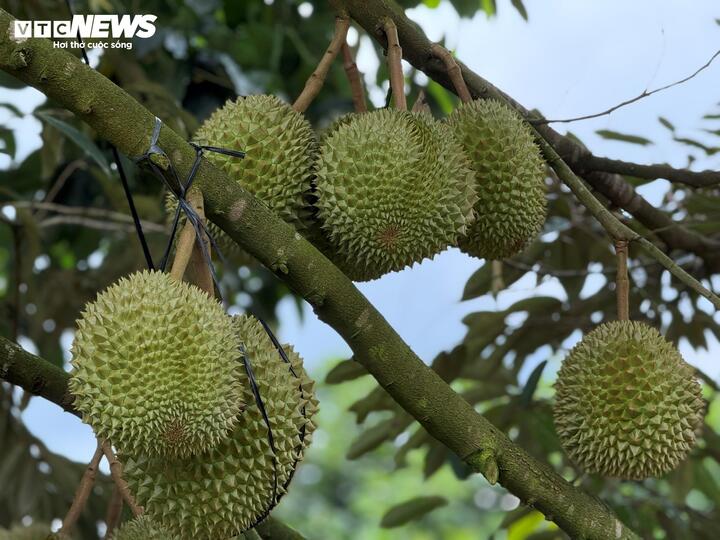
Musang King trees laden with mealy fruits, resulting in a more than 50% drop in prices.
For example, in Nghia Binh commune, Bu Dang district, Binh Phuoc province, a farmer reluctantly sold nearly two tons of Ri6 durians at 17,000 VND/kg ($0.71). The reason was that the mealy condition was so severe that there was no other option.
Mr. N.V.A, a trader from Dak Nong province, confirmed that he was the one who purchased this lot of durians.
“Of course, everyone wants to buy delicious, beautiful durians, but sometimes we have no choice. To be honest, I had already paid a deposit of 60 million VND ($2,520) for this orchard, so I had to buy the durians at 17,000 VND/kg ($0.71). This price may seem low, but it reflects the quality of the fruits. The durians from that orchard were severely mealy and could only be used for making ice cream,” Mr. A. explained.
Thus, the price of 17,000 VND/kg ($0.71) for this lot of mealy durians was considered reasonable by many in the industry, as both parties sympathized with each other’s situation.
We contacted several other traders who had placed deposits to purchase durians in these areas, and many admitted: “Mealy durians cannot be exported, and if we buy them, we can only throw them away. It’s better to lose the deposit of a few million VND than to be stuck with a ton of defective fruits.”
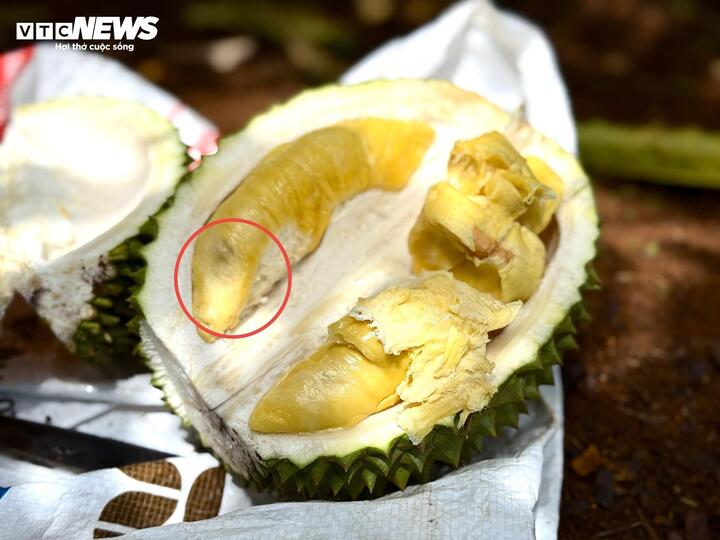
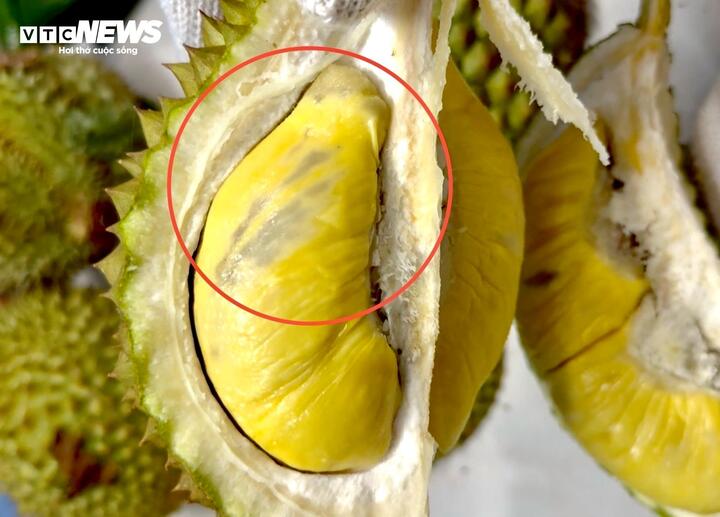
Durian fruits affected by excessive moisture, with traders offering only 25,000 VND/kg ($1.05).
“In many cases, when traders tried to get their deposits back, they were scolded and chased away by the farmers. We understand their frustration, so we either accept the loss of the deposit or buy the durians at a low price and then sell them to ice cream makers,” shared a trader.
According to the farmers, after deducting the cost of care and maintenance, a selling price of 40,000 VND/kg ($1.69) would be considered breaking even. Anything lower would result in a loss, and a price of 17,000 VND/kg ($0.71) would lead to a significant deficit.
Is there a way to “rescue” mealy durians?
Engineer Tran Hai, who has been closely monitoring the situation in Dak Nong, believes that the excessive moisture issue is not entirely unavoidable.
“It’s true that the unseasonal rains this year have been particularly intense. However, another factor is the weakness of the trees, which is often due to an imbalance in nutrition. When it rains, the trees absorb too much water, and the fruit doesn’t have time to develop properly, resulting in mealy durians,” explained Engineer Tran Hai.
According to him, Musang King and Ri6 varieties are the most susceptible to this issue. In some orchards, up to 70-80% of the fruits were affected by mealy rot, leading not only to reduced yield but also to a loss of trust from traders who usually buy the entire crop in advance.
“If traders encounter mealy durians in a few seasons, they will become cautious and hesitant to take the risk. This, in turn, leads to a glut of durians on the market,” he added.

Engineer Tran Hai providing technical guidance to local farmers.
Engineer Hai emphasized the need to address the root cause of the problem. In reality, many farmers only use NPK fertilizer, while durian trees require a balanced supply of major, minor, and trace elements. Imbalanced fertilization leads to uneven tree development, and when combined with excessive moisture, it results in mealy fruits.
He advised farmers to implement proper irrigation and drainage practices, adjust fertilization practices, ensure adequate supply of trace and minor elements, increase technical consultations from the beginning of the growing season, and closely monitor weather conditions to take proactive measures such as covering the trees.
“Trees are like humans; if they don’t get a balanced diet, they will get sick. To prevent mealy durians, we must first ensure the trees are healthy. We may lose this season’s crop, but if we don’t make adjustments, we will lose the next season as well,” Engineer Hai emphasized.
In Dak Nong, Engineer Tran Hai is not just a technical advisor to farmers; he also directly surveys, experiments, and implements practices related to soil, water, and fertilizer, all the way to the fruits.
“Achieving truly clean agriculture is not difficult, but we can’t stop at verbal recommendations. I personally collected 30 samples of fertilizers from the market for testing, and the results were surprising—only seven samples met the cadmium standards,” shared Engineer Tran Hai.

Mealy durians can still be “rescued” if farmers change their care practices.
The fertilizers that met the standards tended to be about 20,000 VND ($0.84) more expensive per bag, which is an acceptable additional cost for a more sustainable and responsible agricultural approach.
Many people think that all fertilizers are the same, but the long-term accumulation of certain chemicals in the soil can lead to hidden toxicity. Without proper control from the beginning, the concept of “clean fruits” remains only on paper.
The technical process that Engineer Hai and his colleagues are implementing includes three mandatory control steps: testing the soil and water before cultivation to determine suitability, testing the fruits on the 60th day to monitor heavy metal accumulation, and conducting a second fruit test on the 110th day while also analyzing pesticide residues.
So far, Engineer Hai has tested 139 durian orchards in Dak Nong, and all of them have tested negative for cadmium in both testing rounds.
“Dr. Vo Tri Thanh: Even Those with a Monthly Income of Just VND 1 Million Should Pay a Tax of VND 1,000”
Dr. Vo Tri Thanh emphasizes that paying taxes is not just a financial obligation but also a social behavior that needs to be cultivated from an early age.
“Streamlining Administrative Codes: A Proposal for 34 Merged Provinces and Cities”
Introducing the dynamic trio of Vietnam’s metropolitan areas, each with their unique codes: Hanoi, with its sleek and sophisticated code of 01, sets the standard for the north. Moving down the coast, we have the enchanting Danang with code 48, a gateway to central Vietnam’s charm. And last but not least, the vibrant Ho Chi Minh City, coded as 79, pulses with energy in the south. These codes are more than just numbers; they represent the heartbeat of each city, reflecting their distinct character and allure.

























